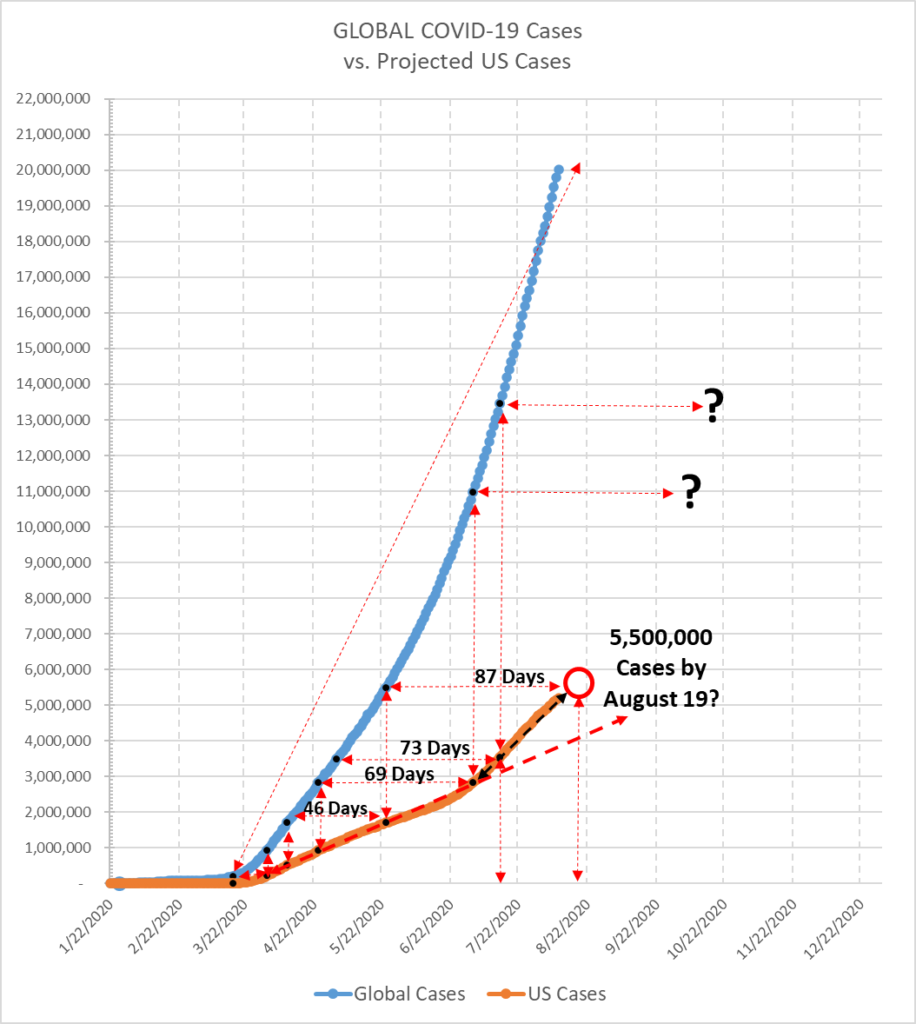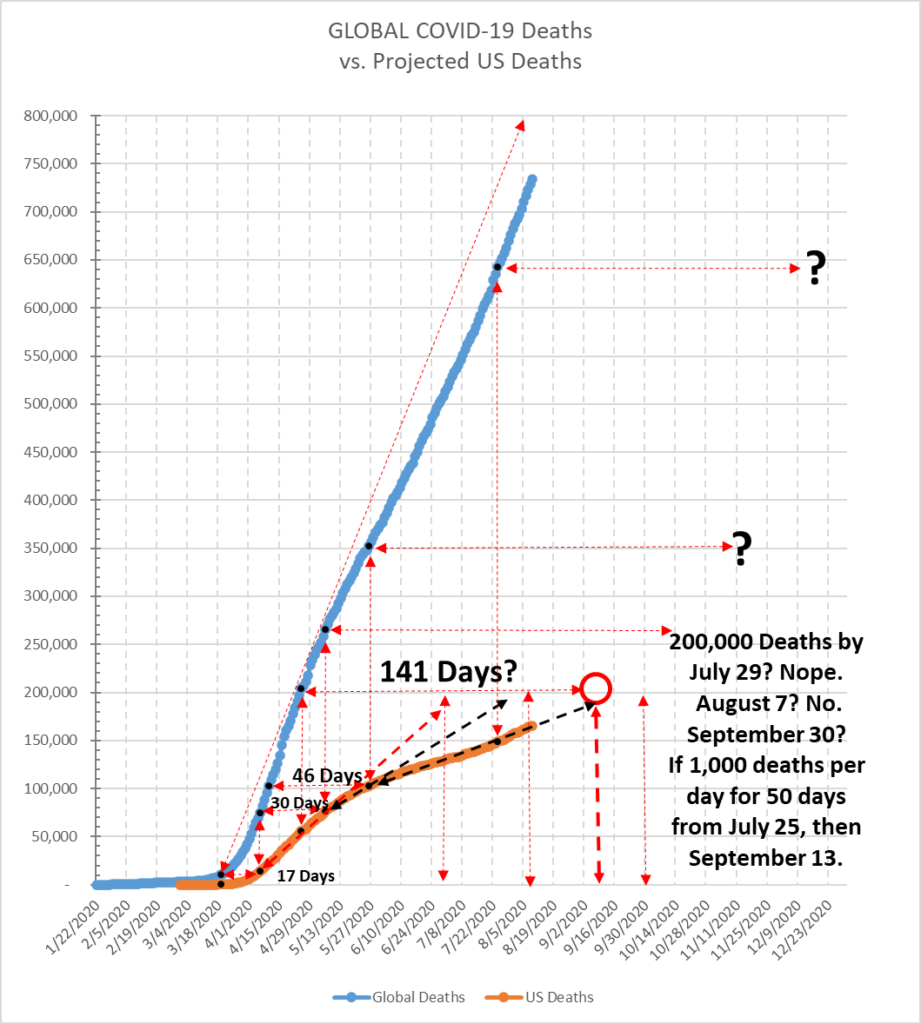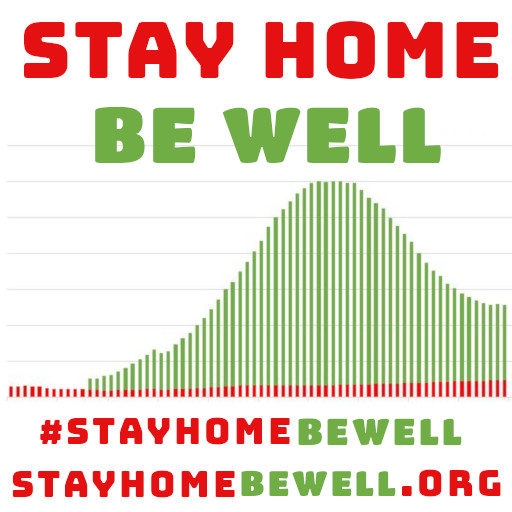Here’s what I’ve been thinking about lately. I don’t know the answer the question I’m about to pose.
What is the magic number?
There are 330,000,000 people in the USA. At the beginning, there was one infection.
At the other end of the range of possibilities, every single one of the 330,000,000 Americans gets infected.
Currently, the reported numbers are 5,150,000 infections and 165,000 deaths. That equals a Case Fatality Rate of 3.21 percent.
“But we don’t know the actual numbers of infections! That three percent figure greatly exaggerates the lethality of this virus!” they protest.
Well, globally, the reported numbers are 19,795,000 infections and 729,000 deaths. That equals a Case Fatality Rate of 3.68 percent. That figure includes those of the United States.
In the rest of the world, excluding the United States, the reported numbers are 14,645,000 infections and 564,000 deaths. That equals a Case Fatality Rate of 3.85 percent.
I’d say that suffices to establish a roughly reliable estimate of how many people who get infected with SARS-CoV-2 and develop COVID-19 die from it.
So, if we reached the end of the possible range of infections, wherein every single one of the 330,000,000 Americans were infected with SARS-CoV-2, then we can pretty reliably project that three percent of that number would die.
Three percent of the population of the United States is 9,900,000.
Assuming acquired immunity (which is a desperately hopeful assumption), that would be the end of it. No one would get infected a second time.
If we do not assume acquired immunity, then the risk exists that people who had been infected once could get infected again. But let’s leave that aside for the moment.
In studies I’ve read about human evolution, the rise of tribes, the establishment of the first agrarian settlements, etc., and how that relates to modern groupings of people, I’ve seen the number 150 cited as the “sweet spot,” at which all members of the group can have direct personal relationships with one another, or be more than just casual acquaintances.
I’m thinking that the number in our context might be higher. I have 427 friends on FB. I don’t really *know* all of you. Some are people I’ve only met once or twice, and with whom I have wanted to establish a connection so that perhaps we might meet again someday. But I would estimate that I actually *know* the majority of you, even if I haven’t seen many of you in decades.
So, how many degrees of separation is close enough?
I personally do not know anyone who has died of COVID-19.
I do personally know two people who have been infected by it. One went through 14 days of absolute hell. The other had a strange dry cough for about 10 days.
I wrote early on that the only way it seemed that those who refuse to consider that this pandemic might be real would be for them to feel it on their own hides, or to know someone who did.
Unfortunately, I suspect that this was not specific enough. Because, for example, if I were to get sick and die, I don’t know if my denier friends would even accept that as real enough to pierce the bubble in which they reside. They might find a way to rationalize it, what with my being a libtard cuck, and all.
Rather, I fear that it needs to touch someone with whom they have identified as an ally and a comrade-in-arms in all of this. When someone who used to stand shoulder to shoulder with them, armed to the teeth on the statehouse steps dies, maybe then they will confide in one another that, “hey, bro, I guess this thing is pretty serious after all…”
So, the question is, what is the critical mass of infections and deaths that has to be reached in order for that balance to be tipped?
If, for the sake of simpler arithmetic, we take as the affinity group sweet spot the number 330 rather than 150, then we can divide the population of the United States by that number and we reach a quotient of 1,000,000. One million people need to die in order for the deniers to come around.
I don’t think this number is accurate, though. Because the distribution of those infections, sicknesses, and deaths is not uniform throughout the population, it is possible that one black or latino or native person might know 10 people who have died, while 10 suburban white kids might still know none.
But at the extreme end of the spectrum, where everyone has gotten infected and 10 million have died, that would mean that one out of every 33 people in the country would have died. At such a level, I suspect it would be safe to assume that everyone would know at least one person who fell into that number.
So, it would seem that the number of people who have to die in the United States before the deniers will accept the reality of this situation is between one million and ten million.
In the last 21 days, an average of just over 1,000 people have died per day. There are 86 days until the US presidential election.
If that daily death rate were continue, then by November 3, the United States will have had 165,000 + 86,000 = 251,000 deaths.
Not enough.


